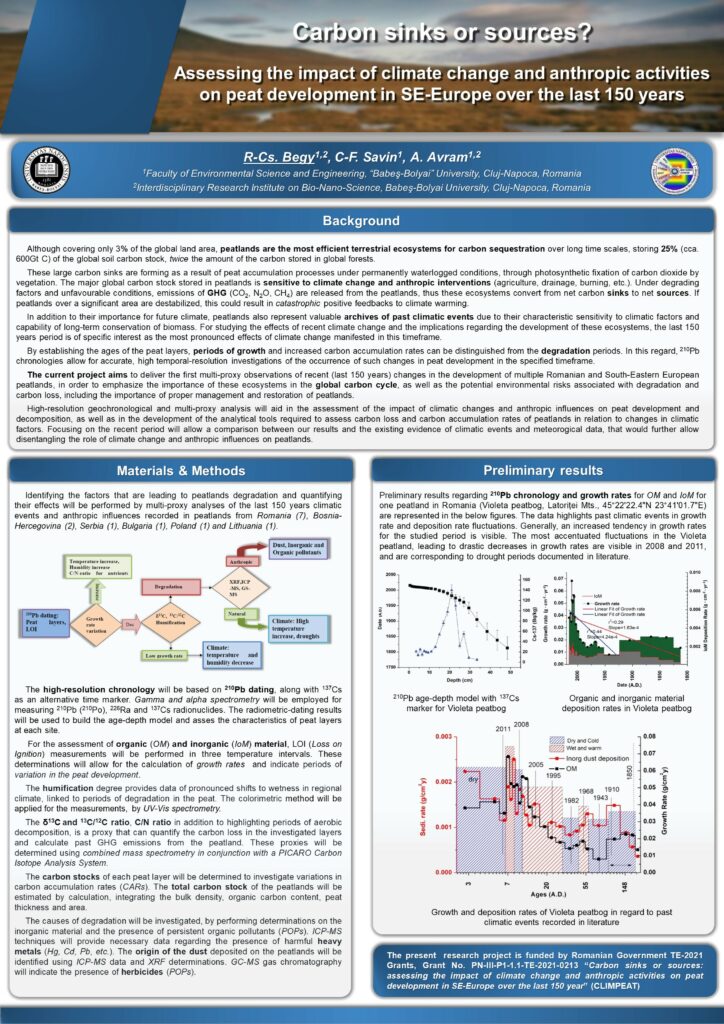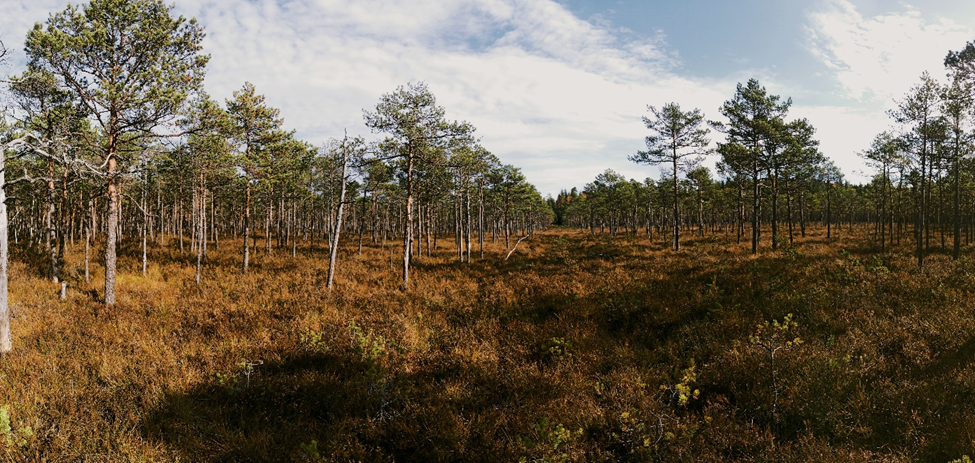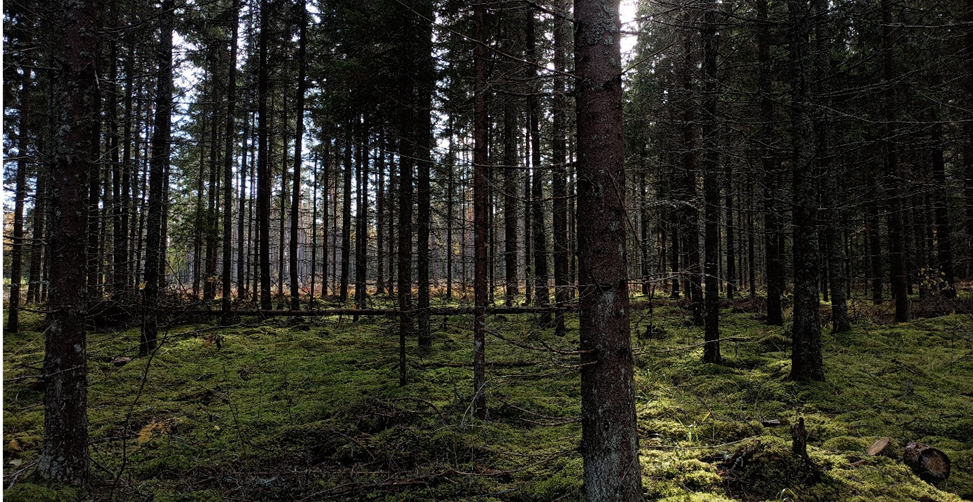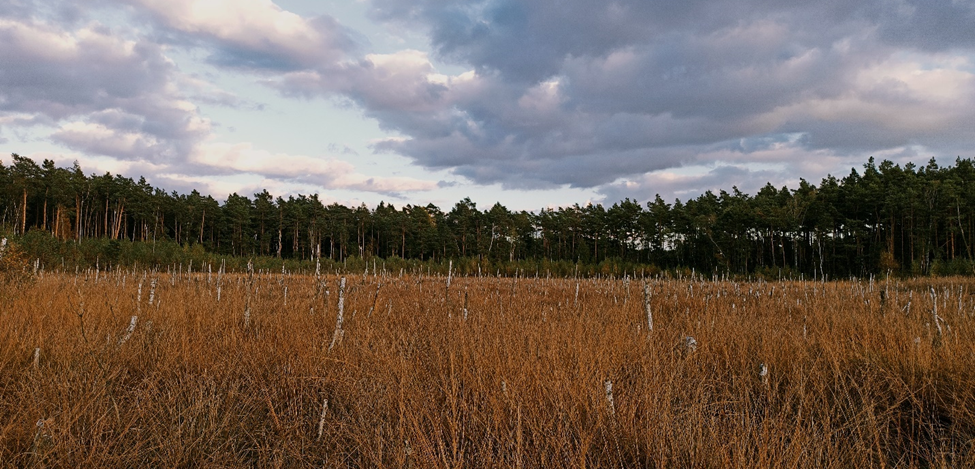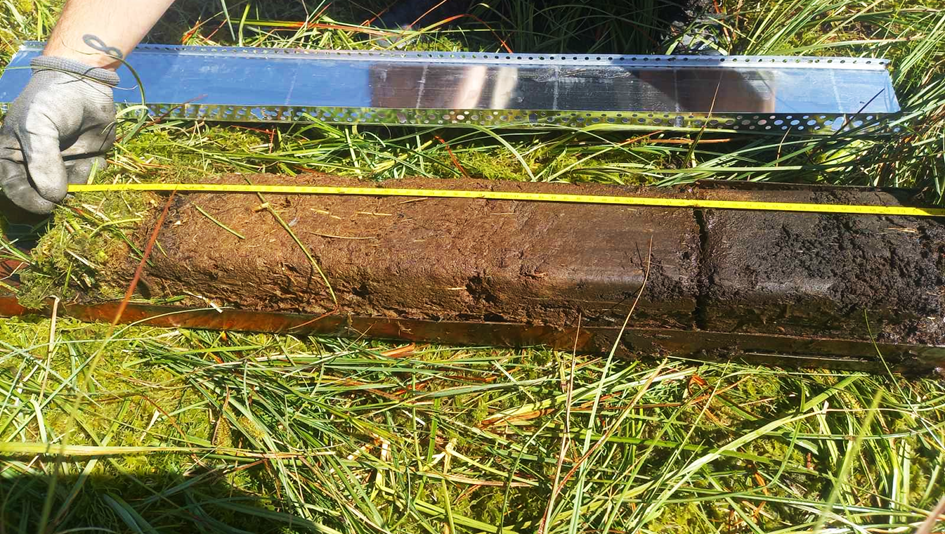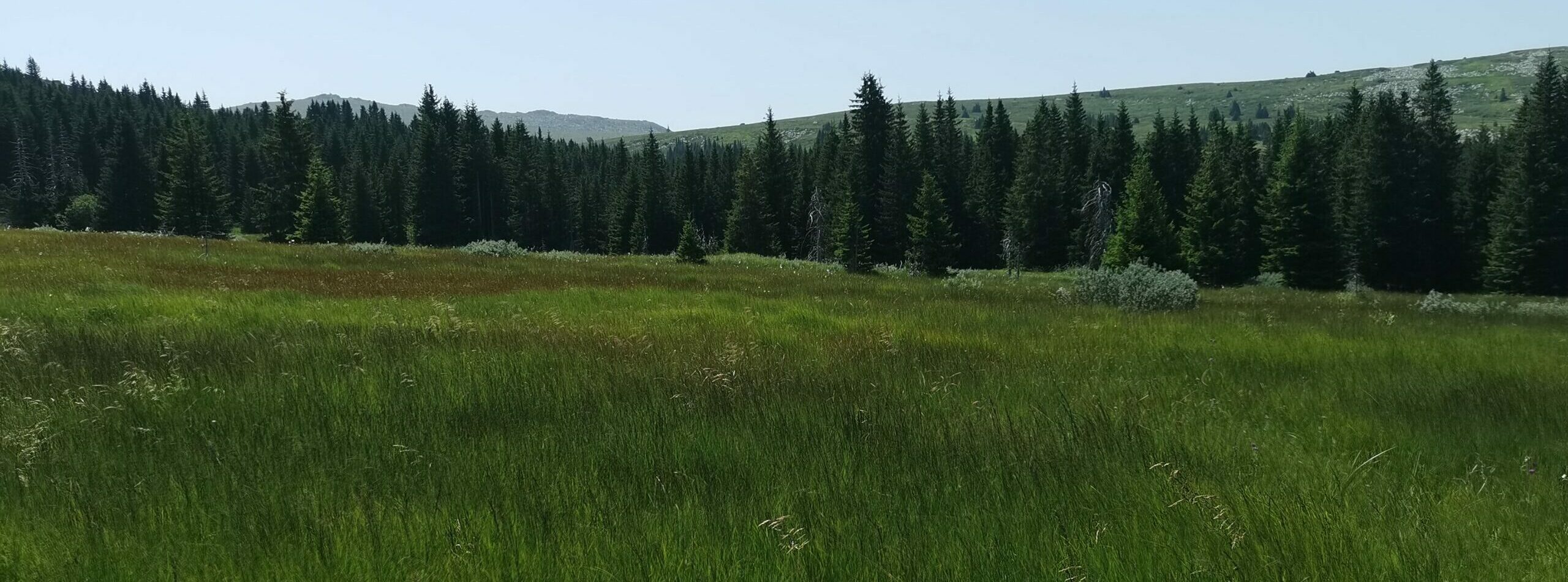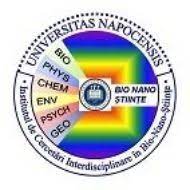INFORMAȚII GENERALE
Schimbările climatice sunt din ce în ce mai vizibile în zilele noastre, fiind accentuate de emisiile de gaze cu efect de seră, precum dioxidul de carbon. Turbăriile sunt ecosisteme terestre care stochează cu un ordin de mărime mai mult carbon decât pădurile. În România, turbăriile acoperă zone extinse, iar investigarea stării și evoluției acestora în trecut este necesară pentru întelegerea fenomenelor ce vor avea loc în viitor. În ultimii 150 de ani, perioada de industrializare a adus numeroși factori antropici care, pe lângă cei naturali, afectează dezvoltarea turbăriilor. Dacă turba se degradează ca o consecință a proceselor biochimice, aceste ecosisteme se transformă din depozite de carbon în surse de carbon, care re-emit gazele cu efect de seră stocate anterior. Studiul nostru are ca scop investigarea zonelor de turbărie, ca rezervoare de carbon, printr-o analiză multi-proxy. Dezvoltarea lor pe parcursul perioadei menționate va fi analizată prin metoda de datare cu 210Pb, iar perioadele de degradare vor fi identificate utilizând analize ale gradului de humificare și fluctuației nivelului apei. Cauzele care duc la degradare, atât naturale, cât și antropice vor fi identificate. Ca obiectiv final, retenția carbonului atmosferic și emisiile de carbon ale turbăriilor investigate vor fi cuantificate. Aceste rezultate vor ajuta la construirea unei baze de date privind integritatea turbăriilor studiate în România și sud-estul Europei contribuind la formarea unei perspective asupra dezvoltării lor în viitor.
Proiectul ”CLIMPEAT” PN-III-P1-1.1-TE-2021-0213 are ca scop evidențierea importanței turbăriilor în ciclul global al carbonului și a susceptibilității lor la schimbările climatice prin analiza retrospectivă a semnăturilor depoziționale a șapte turbării situate în România (și extinsă în Bosnia-Herțegovina, Serbia, Bulgaria, Polonia și Lituania), pentru a furniza informații relevante care să conducă la o mai bună înțelegere a funcțiilor acestor ecosisteme în procesele de sechestrare a carbonului și a necesității unor politici de management adecvate pentru conservarea lor. Actualul proiect va furniza primele observații multi-proxy ale schimbărilor recente (în ultimii 150 de ani) în dezvoltarea mai multor turbării din România și sud-estul Europei. Acestea vor contribui la evaluarea impactului schimbărilor climatice și al influențelor antropice asupra turbăriilor, precum și la dezvoltarea instrumentelor analitice necesare pentru a evalua ratele de emisie și de acumulare a carbonului din turbării în raport cu schimbările factorilor climatici. Printre obiectivele propuse, se numără
(I) Obținerea de informații privind variația în timp a creșterii a turbei prin construirea unei scări temporale de înaltă rezoluție pe baza datării cu 210Pb, pentru siturile selectate;
(II) Descrierea evoluției dezvoltării turbăriilor și identificarea perioadelor de degradare a turbăriilor;
(III) Interpretarea rezultatelor obținute privind perioadele de creștere și de degradare în evoluția turbăriei pe baza informațiilor din literatura de specialitate și a datelor meteorologice;
(IV) Identificarea efectelor naturale și antropice asupra turbei; precum și
(V) Integrarea informațiilor obținute pentru evidențierea importanței turbăriilor în ciclul global al carbonului și a susceptibilității lor la schimbările climatice.
Prin urmare, prezentul proiect subliniază importanța acestor ecosisteme în ciclul global al carbonului, precum și potențialele riscuri de mediu asociate cu degradarea și pierderea de carbon, inclusiv importanța gestionării adecvate și a restaurării turbăriilor, subiecte relevante pentru politicile de management și conștientizarea populației.
Proiectul este structurat în trei etape, astfel:
ETAPA I. Obținerea informațiilor privind variația în timp a creșterii turbăriilor prin construirea unei scări de înaltă rezoluție pe baza datării cu 210Pb, pentru siturile selectate și descrierea evoluției dezvoltării turbăriilor, și identificarea perioadelor de degradare.
În cadrul primei etape s-a realizat activitatea de colectare a probelor, fiind vizate șapte țări din Europa, anume: România, Bulgaria, Serbia, Bosnia-Herțegovina, Polonia și Lituania (Figura 1). Probele obținute au fost prelucrate în vederea determinării parametrilor fizici (conținut de apă, porozitate, fracția materialului organic și anorganic, precum și a densității în probă umedă și uscată). Construcția modelelor de vârstă a fost realizată pe baza metodei 210-Pb, măsurătorile radiometrice fiind efectuate utilizând spectrometria alfa, gamma și spectrometria prin scintillate lichidă.
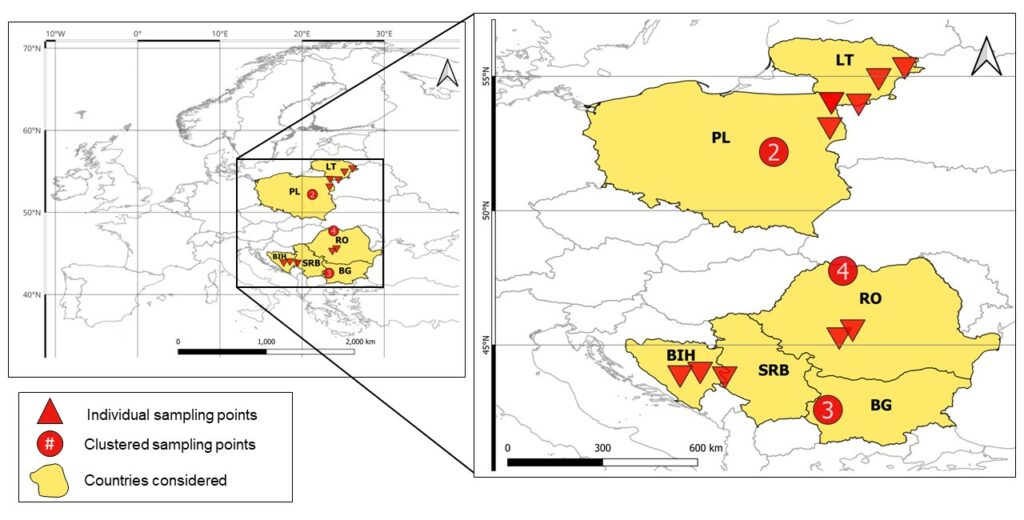
Figura 1. Harta punctelor de prelevare din cadrul turbăriilor vizate de prezentul proiect
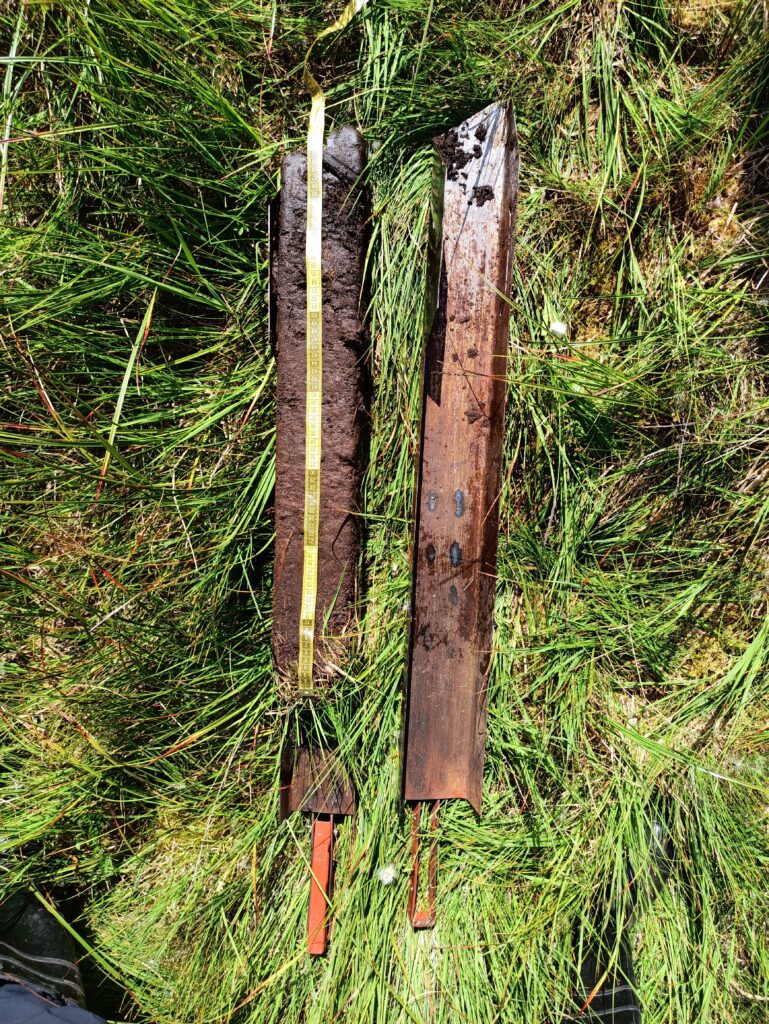
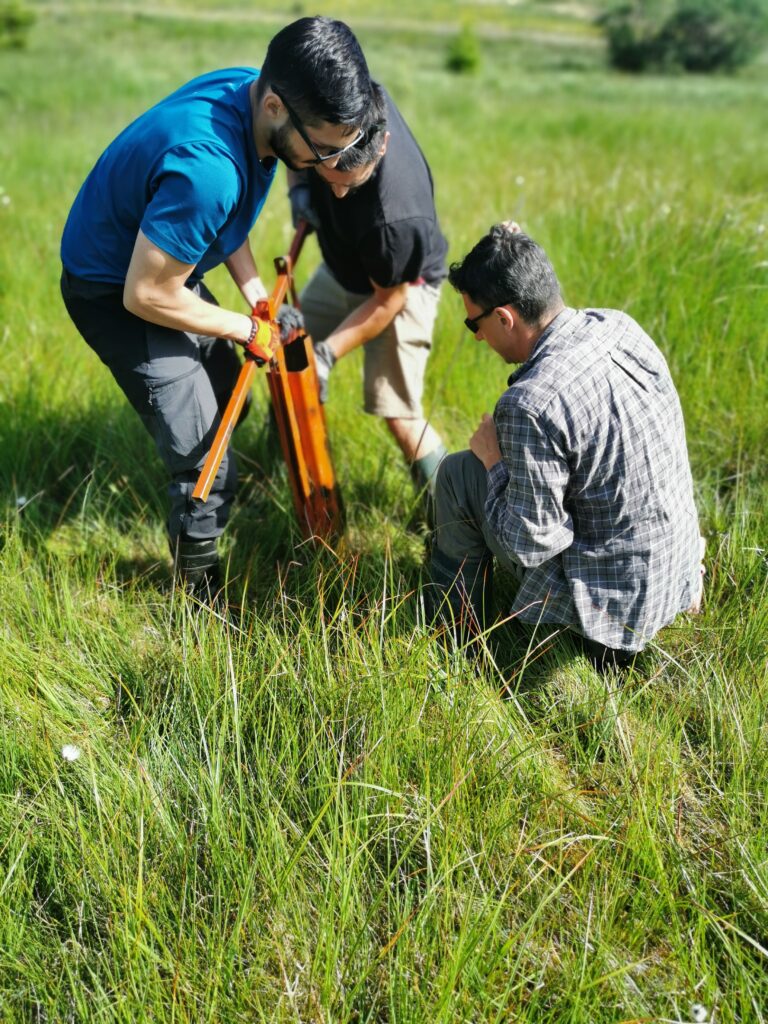
Figura 2. Activitate de prelevare a probelor în teren (dreapta), proba de turbă extrasă (stânga)
Raportul științific integral al primei etape poate fii accesat dând click aici.
ETAPA 2. Interpretarea rezultatelor obținute privind perioadele de creștere și cele de degradare în evoluția turbăriei pe baza informațiilor de arhivă și analizelor multi-proxy, precum și identificarea efectelor naturale și antropice asupra turbăriilor.
În cadrul celei de a-doua etape au fost realizate analizele multi-proxy asupra probelor recoltate, în vederea determinării ratei aparente de acumulare a carbonului în perioada ultimilor 150 de ani, a fluctuațiilor nivelului apei în ecosistem, și a indicilor de humificare a materialului prin spectrofotometrie UV-VIS, aceștia fiind indicativi pentru perioadele de degradare. De asemenea, au fost suplimentar realizate analize asupra susceptibilității magnetice și analize XRF (Fluorescență cu raze X) pentru determinarea compoziției materialului anorganic (metale grele, etc.). Toate aceste măsurători au ca scop descrierea răspunsului turbăriilor la schimbarea factorilor de mediu din ultimii 150 de ani, vizându-se identificarea unor tipare indicative unui răspuns comun la condițiile climatice regionale, precum și identificarea factorilor determinanți în anomaliile identificate.
Raportul științific integral al etapei a-doua poate fii accesat dând click aici.
ETAPA 3. Integrarea informațiilor obținute în vederea evidențierii importanței turbăriilor în ciclul global al carbonului și a susceptibilității acestora la schimbările climatice.
Obiectivul final al celei de a-treia etape este de a integra toate informațiile obținute în etapele anterioare pentru a forma o imagine de ansamblu asupra răspunsului turbăriilor la schimbările climatice forțate antropic din perioada ultimilor 150 de ani. Acest răspuns poate fi estimat prin descrierea dinamicii carbonului în ecosistem, iar având în vedere aria geografică extinsă vizată de prezentul proiect, observațiile pot fi extrapolate la nivelul turbăriilor globale. Toate aceste informații sunt cruciale în o mai bună înțelegere a factorilor ce afectează aceste ecosisteme și a abordărilor necesare în management-ul sustenabil al turbăriilor în viitor pentru a contracara efectele negative asociate conversiei lor în surse de carbon atmosferic.
Raportul final ce cuprinde toate rezultatele obținute în cadrul celor trei etape poate fi accesat dând click aici.
RESURSA UMANĂ

LIVRABILE
Articole științifice publicate în jurnale internaționale indexate ISI
Begy, R.-Cs., Savin, C.-F., Korponai, J., Magyari, E., & Kovács, T. (2024). Investigation of the last two centuries sedimentation dynamics in high-altitude lakes of Southern Carpathians, Romania. Scientific Reports, 14(1). https://doi.org/10.1038/s41598-024-51812-2
Kelemen, S., Savin, C.-F., Timar-Gabor, A., & Begy, R.-C. (2023). A comparative study on digestion methods for 210Po determinations by Alpha Spectrometry on peat bog samples. Journal of Radioanalytical and Nuclear Chemistry. https://doi.org/10.1007/s10967-023-09157-z
Begy, R-Cs., Savin, C.-F., & Ruskál, A. (2023). Recent carbon sequestration dynamics in four temperate se European peatlands using 210Pb dating. Journal of Environmental Radioactivity, 264, 107208. https://doi.org/10.1016/j.jenvrad.2023.107208
Participări la conferințe internaționale și naționale
11th International Conference on Radiation, Natural Sciences, Medicine, Engineering, Technology and Ecology (RAD11)
Herceg Novi, Montenegro 19-23 June 2023 (Website https://www.rad2023.rad-conference.org)
- Prezentare orală ”210Pb dating as a fundamental tool in retrospective analyses of peatland recent carbon dynamics in the context of global climate change”
14th International Conference on Methods of Absolute Chronology (MACh 2023)
Gliwice, Poland 17-19 May 2023 (Website https://mach2023.polsl.pl)
- Prezentare orală ”210Pb chronology applications in retrospective analyses of peatland carbon dynamics in Romania and Bosnia-Herzegovina”
VIII. Terrestrial Radioisotopes in Environment International Conference on Environmental Protection (TREICEP)
Vonyarcvashegy, Hungary 4-7 October 2022 (Website http://www.treicep.com)
- Prezentare orală ”210Pb chronology applications in retrospective analysis of recent carbon accumulation rates in Romanian peatlands”
- Prezentare poster ”Carbon sinks or sources: assessing the impact of climate change and anthropic activities on peat development in SE-Europe over the last 150 years”
ENVIRONMENT & PROGRESS Symposium: Sustainable Development: Approaches and Solutions for Resilient Communities
Cluj-Napoca, Romania May 18-19, 2023
- Prezentare poster ”Carbon sinks or sources? Assessing the impact of climate change and anthropic activities on peat development in SE-Europe over the last 150 years”
